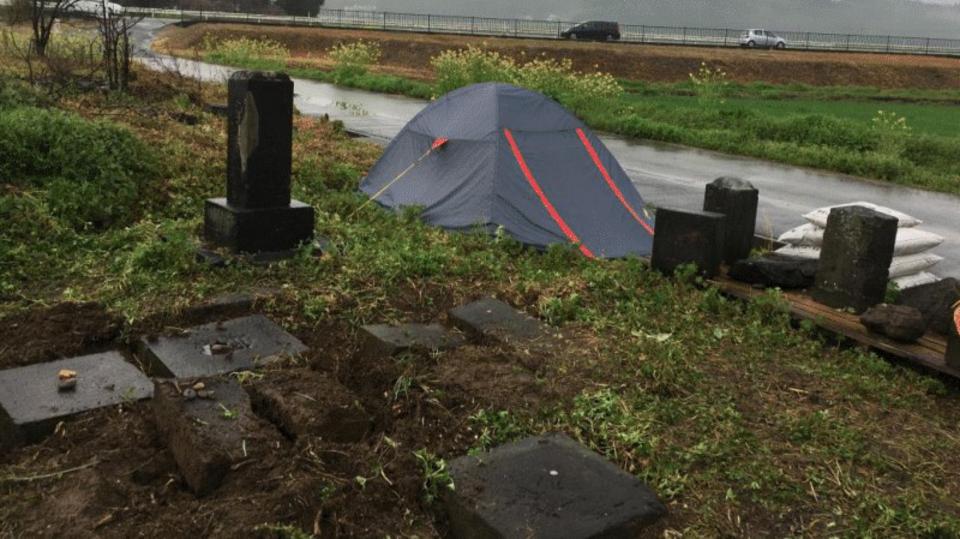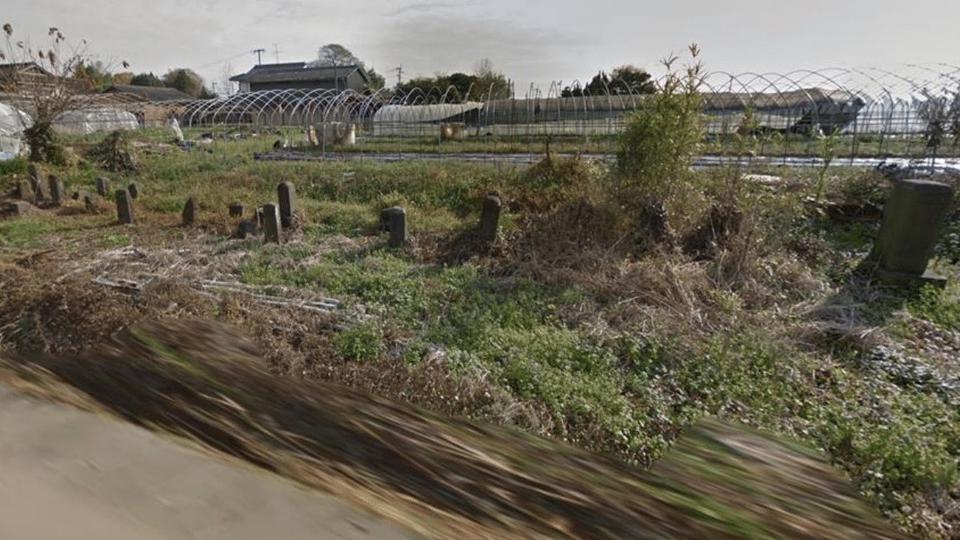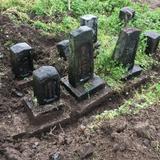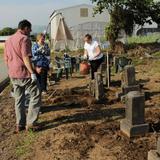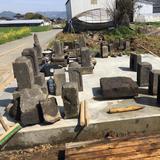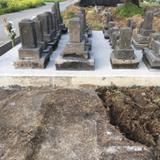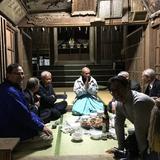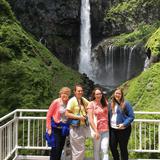| Bret Hamatake diligently worked on his family grave site, even on the rainy days. 2019 by Intellectual Reserve, Inc. All rights reserved. | 1 / 12 |
“To cradle the headstones of ancestors as I dug them up, cleaned them up, and placed them on a clean slab was not the usual family history experience,” conveyed Bret Hamatake, oldest son or “chonan” of seven known generations of Hamatake sons. Though a fourth generation Japanese-American, Bret Hamatake, from Grantsville, Utah, has taken responsibility upon himself to research family names and restore the ancient family cemetery in Nagasaka, Yamaga City, Kumamoto Prefecture.
In April 2017, Bret’s wife, Jeanene, and their daughter, Anna, began researching the Hamatake name on FamilySearch. Sister Chihiro Harper, at the Family History Library in Salt Lake City, translated birth and death records to prove relationship, in order to request koseki records, which are Japanese household records kept in local city halls. They then initiated requests to receive koseki for their Hamatake, Nagata, and Morikawa family lines. They were unsuccessful in requesting the Hamatake line, as they had only a partial address of the original household in Yamaga, Kumamoto, Japan.
Upon further research, Jeanene and Anna discovered that information had been recorded and temple ordinances had been performed for a Hamatake family. The name of the submitter was Itou Keiko. Jeanene began to build a correspondence relationship with Sister Ito, though no family relationship connection has been made. Sister Ito willingly researched the immigration records there in Japan and found the complete address where Bret’s great-grandparents last resided before immigrating to America. With this newfound information, they were able to request and receive their Hamatake family koseki. Sister Itou also assisted Bret in obtaining his Kiyama and Mitsui family koseki records from the Yamaga City Hall.
“It was amazing,” Bret said, speaking of the 40 pages of koseki records that had been obtained. The records contained names and dates going back to the mid-1800’s to the Meiji restoration. Sister Chihiro Harper, stepped up again, and graciously translated all the koseki records, providing names and birth and death dates of their ancestors. The Hamatake family worked frantically to get temple work done, baptisms first, so that more miracles could occur.
After discovering the correct address of the Hamatakes in Yamaga, and with the help of Hamatake Terumitsu, whom they recently befriended on Facebook, they were able to find the general area where the family cemetery was located.
Up until this point, Bret had known very little about the Hamatake family. He knew that his father, Robert Hamatake, and his grandfather, Ichiro Hamatake, had both been born in Sacramento, California. He also knew that his great-grandparents, Hamatake Heizo and Kiyama Miyoshi immigrated from Kumamoto, Japan, to Sacramento, California, USA, in the early 1900’s hoping to find a better life.
In 1925, Ichiro Hamatake, Bret’s grandfather, toured Japan with his two brothers and other members of the Sacramento Nippon Stars, a Sacramento baseball team. This team was comprised of Japanese-American young men. Bret and Jeanene went to the National Archives in California, where they found the original passport that Bret’s grandfather, Ichiro, used while traveling to Japan with the Nippon Stars. Bret feels fortunate enough to possess a photo album with pictures of the team members as they visited various sites around Japan. His grandfather took photographs from Nikko to Kumamoto.
Sister Hamatake relays the ‘miracle of the postcard’, as she coins it. Sister Itou sent an inquiring postcard to the last known family address on behalf of the Hamatakes in America, in hopes of finding family members and information about the family. Not knowing where to leave it, as the address was no longer inhabited by Hamatakes, the postal worker went door to door looking for a Hamatake who was willing to respond to the postcard. He inquired at the home of Gotou Futoshi, whose wife was a Hamatake. The postal worker found Gotou San’s daughter, Eri, at home. She felt the importance of the postcard and accepted it.
On a crisp morning, after a cleansing rainstorm, Gotou Futoshi found the Hamatake cemetery. It was overgrown with bamboo, vines, and wild grasses, but, miraculously, the rain had highlighted the engraved names on the headstones enough that the names could be read. After this discovery, Gotou San answered the postcard. He alerted Bret Hamatake that his family cemetery had been found.
This good news started a series of events. Gotou San sent Bret photos of the cemetery and the street it resided on. Hamatake Chieko, who lives directly behind the cemetery, sketched the names and dates from the Hamatake headstones. It was thrilling for Bret to see the cemetery on Google street view.
Bret and Jeanene Hamatake and their three daughters Sarah (26), Amanda (22), and Anna (17), saw more miracles as they began formulating plans to visit Japan. Their research efforts intensified. By using built up sky miles rewards, four of the five tickets were paid for.
On May 9, 2018, the Hamatake family arrived at the Haneda airport in Japan. “It was one thing to be in the same country as my ancestors, but another thing to stand in the same places my ancestors stood to honor their ancestors,” Bret said, as he remembered their first trip to the cemetery. “We were guided there.”
Bret said of the experience, “there was an abundance of signs that they really lived. We felt their presence.” Looking back, Bret reflected: “Standing there I could black out the modern world around me and feel what it was like to stand where they stood. They were prosperous, religious people, worshipping as they knew how.”
During their research, a fourth cousin on his great-grandmother Kiyama’s side, was found living near the old home site. With traditional Japanese music streaming through the speakers, Bret and his family traveled down a road which his great-great grandfather, Kiyama Momosaku, built, where the family raised sweet persimmons and millet. They also visited the shrine where many of the Kiyama and Mitsui ancestor’s remains are kept.
The Hamatake’s trip included four weeks of family history and re-enactments of photographs matching the photos of his grandfather on the baseball team tour. Together, the family traveled to Tokyo, where Bret served a previous mission for The Church of Jesus Christ of Latter-day Saints. They also toured Mie-ken, where his grandmother Morikawa Shigeko’s ancestors lived, and Hiroshima, Osaka, Nara, Kyoto, and Nikko.
On March 4, 2019, Bret Hamatake returned to the land of his fathers. He felt that it was his responsibility to repair the family cemetery. Traveling alone this time, he stayed in a capsule hotel, and rode a bike about five miles to and from the cemetery each day.
Bret decided to do the work himself. He placed the stones in stacks in an attempt to maintain the original order and appearance of the headstones as arranged after the death of each family member. “It was so meaningful to do it myself,” Bret contributed. The headstones were large and heavy, making the labor difficult. He was told that the large size of the stones suggested that his ancestors may be of Samurai or Shizoku heritage, though nothing has been determined.
“Your ancestors must be so happy!” people commented to Bret as they drove by the graveyard where he worked. Possible relatives stopped by to admire his efforts. Among the well-wishers, Bret met a man who looked like his dad.
In spite of adverse weather conditions, Bret arrived at the cemetery daily to perform his admirable efforts. On one rainy visit, Gotou San told him “the rain is the tears of your ancestors.”
Bret attended the annual Nagasaka Narenarenasubi-odori, or Eggplant Dance. a ritual festival which occurred during his visit. Men dressed in hemp costumes danced around a drum, while praying for a good rain and harvest. Hamatake men were among the dancers. The city elders invited him to sit with them. They knew what he was doing and were very supportive of his work and his desire to connect with his ancestors.
Though he has not been able to make connections, Bret is sure that many members of the village are his relatives.
Regarding the miracles that have transpired and the numerous records that have been discovered, Jeanene Hamatake said, “the one thing I’ve learned on this journey is that Heavenly Father will magnify your efforts. We had no idea it would be so big.”
Bret summarizes this experience: “Once you make a connection in family history, you research because you want to; and once you feel the spirit and the spirit of ancestors, then success comes.”
